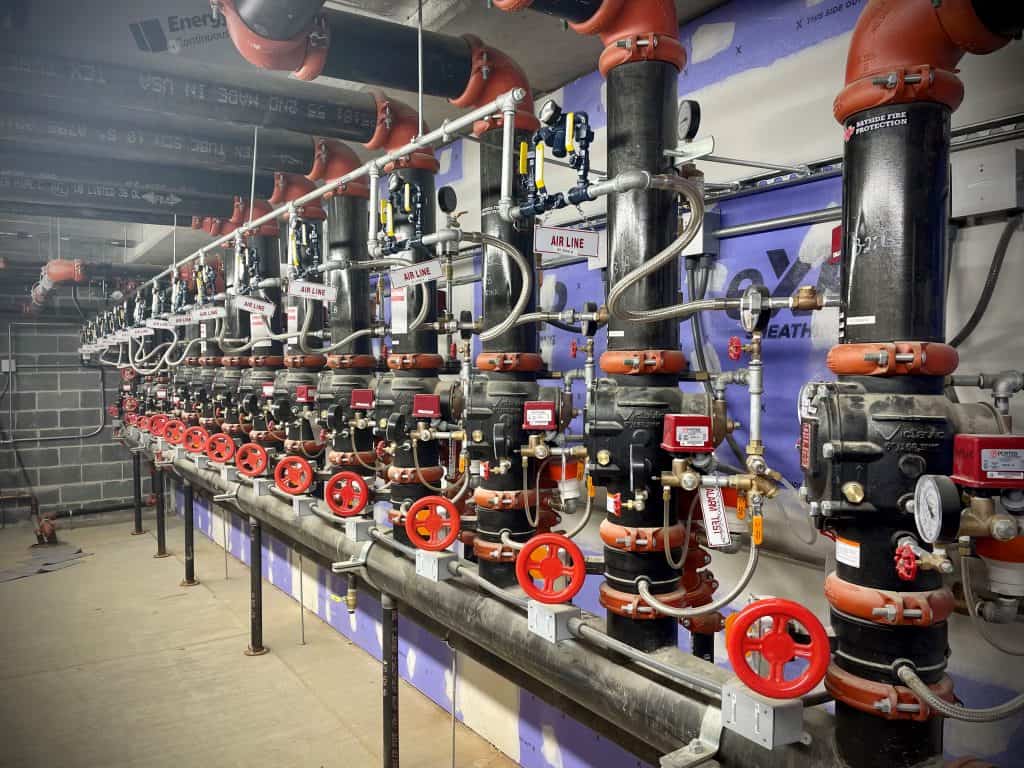Services We Offer

Service, Inspections,
& Preventative Maintenance
Keep Your Systems Inspected
NFPA Guidelines, Recommendations, & Testing/Inspections Schedules
FIRE SPRINKLER
How often should my fire sprinkler system be inspected?
An inspection is essentially a visual once-over to check the status of your sprinkler system. According to NFPA 25, this is the inspection schedule you should follow:
- Weekly or monthly: Inspect the gauges in dry, pre-action, and deluge systems as often as once a week. Wet pipe system gauges can go a month between inspections.
- Quarterly: Every three months, have the water flow alarm devices, valve supervisory alarm devices, supervisory signal devices, control valves, and hydraulic nameplates inspected.
- Annually: Once a year, inspect the hanger/seismic bracing, pipes and fittings, information signage, and spare sprinklers.
- Every 5 years: Conducting an internal inspection of sprinkler piping is only required once every five years.
How often should my fire sprinkler system be tested?
Tests are comprised of more in-depth physical checks.
NFPA 25 dictates this fire sprinkler testing schedule:
- Quarterly: In order to be as effective as possible, fire sprinkler mechanical devices should be tested quarterly.
- Semiannually: Every six months, vane and pressure switch type devices must be tested.
- Annually: Full testing and tagging should be performed annually. During a complete fire sprinkler system test, the technician should perform physical checks on all parts of your fire sprinkler system. These checks include water flow tests, fire pump tests, antifreeze concentration tests (in applicable systems), alarm tests, and trip tests of dry pipe, deluge, and pre-action valves.
- Every 5 years: Sprinklers exposed to extra-high temperatures and harsh environments, along with gauges on all sprinkler system types, should be tested or replaced every five years.
- Every 10 years or more: Dry sprinklers should be tested or replaced every 10 years. Fast-response sprinklers should be tested after 20 years in use and every 10 years after that. Standard response sprinklers should be tested after 50 years in use and in 10-year intervals after that.
Fire Alarm
How often should my fire alarm system be tested?
You trust your fire alarm to always be ready to alert you and your facility when a fire breaks out. But how can you have the peace of mind that the system will work when you need it to? The answer is through regular testing and inspection of your fire alarm system. Periodic testing & inspections help you:
- Identify components of the system that may have been changed or damaged.
- Identify impairments or deficiencies in the system.
- Ensure that each fire alarm device is working properly.
- Keep you compliant with federal, state, and local fire codes.
The National Fire Protection Agency (NFPA) has developed standards for testing and inspection of fire alarm systems. NFPA 72 lays out the frequencies that your system needs to be inspected as follows:
Annually
All equipment should be visually inspected on an annual basis by a qualified professional. During this inspection, our technicians will ensure that there haven’t been any changes to the system that could impact its performance. They’ll assess building modifications, device locations, obstructions, damage, and cleanliness. They will also test all components of your system and document any deficiencies that arise.
Semiannually
Quarterly
Other Frequencies
NFPA 72 also prescribes that certain components be inspected and/or tested on a monthly, weekly, and daily basis. Smoke detector sensitivity testing should take place within one year after installation and then every two years after that.
Bayside Fire will help you develop a plan for testing and inspections specific to your business and location.